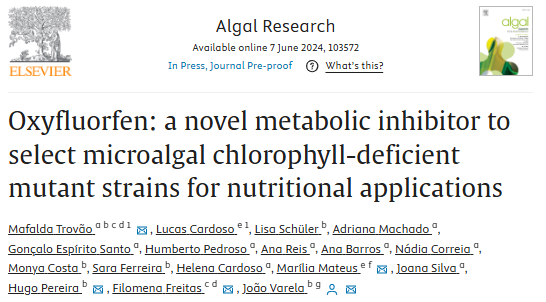

TITLE
Oxyfluorfen: a novel metabolic inhibitor to select microalgal chlorophyll-deficient mutant strains for nutritional applications
JOURNAL
Algal Research
AUTHORS
Mafalda Trovão, Lucas Cardoso, Lisa Schüler, Adriana Machado, Gonçalo Espírito Santo, Humberto Pedroso, Ana Reis, Ana Barros, Nádia Correia, Monya Costa, Sara Ferreira, Helena Cardoso, Marília Mateus, Joana Silva, Hugo Pereira, Filomena Freitas, João Varela
ABSTRACT
Nowadays, there is an increasing demand for novel feedstocks and alternative protein sources to meet global needs. Because of their rich nutritional profiles and high protein contents, microalgae-based food products and supplements are being developed. Nonetheless, these products present organoleptic characteristics such as taste, smell and colour that are often considered unpleasant by human and animal consumers. To address this constraint, strain improvement approaches such as random mutagenesis have been used, which combined with the right selection strategy, lead to more appealing microalgal biomass. In this work, a novel selection strategy using oxyfluorfen, an inhibitor of the chlorophyll synthesis pathway, was applied for the first time to isolate chlorophyll-deficient strains of Scenedesmus rubescens and Chlorella vulgaris upon treatment with ethyl methanesulfonate (EMS). With this approach, one S. rubescens brownish (37Y01) mutant strain, as well as two C. vulgaris mutant strains, one yellow (31Y15) and one white (31 W62), were obtained. S. rubescens 37Y01 displayed a reduced protein content of 19.1 % dry weight (DW) compared to that of the wildtype, which presented a protein content of 25.0 % DW. C. vulgaris wildtype and mutants exhibited higher protein contents, in the 42.8–44.3 % DW range, compared to Scenedesmus rubescens (p < 0.05). The selective pressure of this inhibitor allowed the selection of S. rubescens and C. vulgaris mutants displaying 55 % and 95 % decrease in chlorophyll content, respectively. The reduced chlorophyll content greatly improves the sensory properties and consumer acceptance of established mutants, increasing the potential of both strains as feedstocks to develop novel food products.



